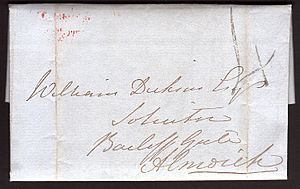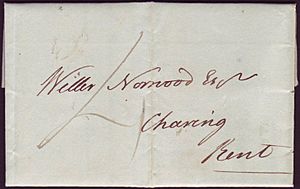Uniform fourpenny post facts for kids

The uniform fourpenny post was a special way to pay for letters in the United Kingdom of Great Britain and Ireland. It only lasted for a short time, from December 5, 1839, to January 9, 1840. This new system was the first step in a big plan to change how the Royal Mail delivered letters in the 1800s.
Contents
Why the Fourpenny Post Started
The Postage Act of 1839
A new law called the Postage Act was passed on August 17, 1839. This law was meant to bring in a "Penny Postage" system. It gave the government department in charge of money, the Treasury, until October 1840 to start this new system.
Public Reaction to the 4d Rate
However, people were not happy with the temporary price of fourpence (4d). They felt tricked because they expected the price to drop to just one penny (1d). Because people were so unhappy, the Fourpenny Post was stopped very quickly.
The Penny Post Arrives
The uniform penny post began on January 10, 1840. From this date, it cost only 1d to send a letter weighing up to one ounce if you paid in advance. A few months later, in May 1840, special stamps were created to pay for postage. These were the famous Penny Black and Two Penny Blue stamps.
How the Fourpenny Post Worked
Paying for Letters
From December 5, 1839, to January 9, 1840, a standard charge of 4d was set for letters. This applied to letters weighing up to half an ounce, as long as you paid before sending them. Before this, the cost of sending a letter depended on how far it went and how many sheets of paper it had.
Weight and Cost
If a letter weighed one ounce, it cost 8d. For every extra ounce, up to 16 ounces, the cost was another 8d. If you sent a letter without paying first, it cost double the normal rate. If a letter already cost less than 4d, its original lower price was still used.
More Letters Sent
This new system made it easier and cheaper to send letters. The number of letters sent increased a lot! For example, in the last week of November 1839, the London post office handled about 1.5 million letters. By the third week of December, this number grew to over 2 million. By late February 1840, it was over 3 million letters!
Special Marks on Letters

Letters sent during the Fourpenny Post period had a special mark on them. This mark was the number '4'. Sometimes, it was written by hand. Other times, it was stamped onto the letter using a special handstamp.
Where the Handstamps Were Used
Only a few cities in Great Britain and Ireland received these official handstamps. Cities like Dublin, Glasgow, and Edinburgh had them. Interestingly, London did not have an official handstamp for the '4'. Some smaller towns even made their own unofficial handstamps!

